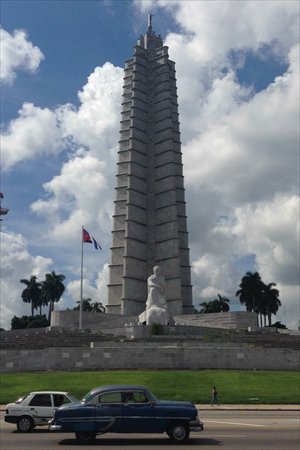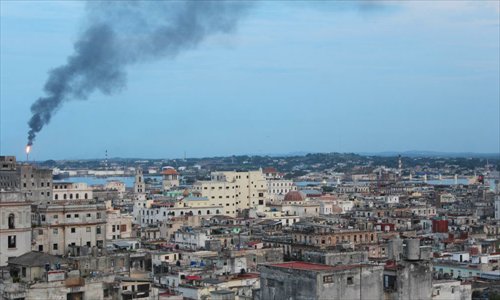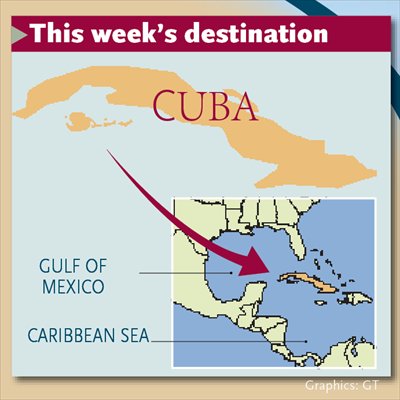HOME >> LIFE
Hopeful Havana
By Vera Penêda Source:Global Times Published: 2015-3-6 5:03:01
Colorful scenes from another era

Memorial a Jose Martí Photo: Vera Penêda

A view of Havana from the Bacardi Building Photo: Vera Penêda

This week's destination
Cuba, but mostly its beating heart of Havana, will not be the same after more than 50 years of closure to the world. The US economic blockade over Cuba remains in place, but since both countries announced a move towards a more normal relationship, the Caribbean island has been filled with a renewed hope for change. Cubans seem particularly happy at welcoming more tourists, as an increase in the number of visits can showcase Cuba to more people and bring the island to a new era of economic and social transformation. So, if you have yet to embark on a trip to Havana, now is the perfect time to visit the capital of the biggest island in the Caribbean. Forget the tour packages and the beach resorts. Havana is better enjoyed and understood when you decide to roam around town and take the time to talk and listen to the hopes and woes of Cubans over a Cuba Libre.Surrounded by colonial buildings and paced off by colorful vehicles borrowed from the old Soviet Union roads, Havana is the perfect scenery for shooting a spy movie set in the 1950s. The city evokes the decadent charm of a country that stopped in time.
Start your visit on Prado Street, the European-style boulevard and the main artery in the city, for a first taste of Havana's urban life. Dodge the old cars and the rickshaws, while circling the Capitolio Nacional. The house of the Cuban Congress for three decades, the grand building hosts the Cuban Academy of Sciences and the National Library of Science and Technology since 1959. Unfortunately, it's closed for renovations. Around the architectural behemoth, you'll find Cubans hanging on colorful balconies and sitting on the doorsteps of two-story colonial buildings.
The construction would be worthy of the wealthy, if it wasn't for its poor, crumbling shape, mostly due to the lack of maintenance through the years and the overcrowding.
Next-door is the neoclassical building of The Real Fábrica de Tabacos Partagás, one of Havana's oldest cigar factories. The place has a distinct, earthy aroma oozing from the shelves packed with cigar boxes. On a corner, you'll find a Cuban woman rolling cigars in a little desk. A box of 20 "puros" (cigars) costs about $250, but you can just follow one of the street sellers underground and bargain for your box.
At the heart of the Revolución
In front of Hotel Inglaterra, get a seat on the top deck of one of Havana's tour buses for an overview of the city. The bus will drive you through sites like the Plaza de la Revolución, the Malecón (the city's 8 kilometer-long sea drive) and the Cólon Cemetery. You can hop on and off the bus all day for 5 CUC ($6).
Get off at Plaza de la Revolución, Havana's biggest and "most official" square flanked by the grey and square buildings of the Cuban government. The Ministry of Internal Affairs and the telecommunications building stand out due to the huge murals of Che Guevara and Camilo Cienfuegos, a Cuban hero of the revolution, that decorate the facade of the buildings respectively. Atop the small hill, you won't miss the Memorial a Jose Martí. One of the most revered creators of the Cuban Revolutionary Party, Martí sits in a pose similar to Rodin's sculpture The Thinker and is the tallest structure in Havana at 138.5 meters.
Walking off the square, you'll find yourself in Vedado, a 50s kitsch, middle-class neighborhood that will lead you to the Malecón.
Along the way, pay attention to the revolutionary billboards and wall art dedicated to socialist mottos and figures, the Cuban substitute for modern advertising.
Plaza Vieja
It's time to get lost in the narrow streets of Old Havana neighborhood, the gem of the city. Head straight to the Plaza Vieja and enjoy the mix of Cuban baroque and art nouveau architecture around the square. Houses usually have their doors open and you can take a peak inside, Cuban domains are modest but clean and proud, with flowers on the porches and a smile to greet passers-by. Some houses became art galleries; others are underground shops that sell burned DVDs and CDs, Latin-American soap operas and hip-hop music are the best escape in a country where the official channels of Cuban and Venezuelan TV provide the only window to the world. Salsa and Cuban pop echo into the streets.
Live music is easy to find and you can usually see local outfits hitting their drums and shaking their maracas at La Bodeguita del Medio. Endorsed by the likes of poet Pablo Neruda and most importantly the novelist Ernest Hemingway, the restaurant-bar claims to be the birthplace of the mojito cocktail since the drink was prepared at the bar in 1942. The walls are covered with memorabilia, photos and messages that tell tales of the hangout and the island.
Continue your stroll through Obispo Street, old Havana's main artery, which is car free and packed with shops, music bars and art galleries. Before you leave the old quarter, I recommend visiting the Bacardi building, the first Art Deco edifice built in Havana for the headquarters of the liquor company in the hands of the Bacardí family.
Art and fun
The magnificent Museo de Bellas Artes (Museum of Fine Arts) is by far the best of Havana's institutions. It showcases the largest art collection in the country, and is divided in two separate sections (located in two different blocks).
The Art Deco building behind the Museum of Revolution is dedicated to Cuban art and offers collections from the colonial times up to Revolution-inspired work and contemporary artworks.
You can get a taste of local dishes at one of the paladares, small Cuban restaurants serving homemade food, which are one of the few types of private-owned business (cuentrapropismo) allowed by the Cuban government. Go to at Doña Blanquita and order the pineapple chicken with black beans and rice and you will not be disappointed.
When night falls go for a drink at Casa de la Música, one of the most popular venues in town for live music.
There are daily concerts by famous Cuban bands and the party usually starts at 5 pm.
Rules of thumb
Word of advice: Internet access is extremely limited in Cuba, so make sure you arrange for your accommodation and car rental before you land on the island. Take a travel book and a basic first-aid kit as medicine is expensive and sometimes difficult to find on the island. There is still a double currency circulating in Cuba: the Cuban peso (CUP) and the Cuban convertible peso (CUC) and neither is exchangeable in foreign markets. You can exchange money upon your arrival at José Martí International airport in Havana. The CUC is pegged to the dollar and 1 CUC = 26.5 CUP. Nearly all consumer goods are priced in CUC, although most Cubans receive their salaries in CUP.
When to travel: Cubans call their country the "land of eternal summer." Cuba has a warm tropical climate with two distinct seasons and temperatures that range between 18-35 degrees. The best time to visit is during the dry season, from December to May, when you'll have warm sunny days. From June to November, the weather is hot, humid and is very likely to rain. Watch out for the hurricanes! The season begins in June and it can last until November.
Where to stay: Aside from international hotels, the best option is to search online and look for private rental services. Cubans are allowed to rent bedrooms to foreigners. Rooms are modest but clean and usually comfortable. Prices range from 25-40 CUC per night ($28-$43) and breakfast can be included.
Where to go for Wi-Fi: You can access the Internet from one of the computers at the Telepunto points located in the city center, but international hotels are the only place where you can get decent Wi-Fi in Cuba. Prepare to pay about $14 for two hours.
What to buy: The Museum of Tabaco and the Museum of Rum are good places to buy cigars and rum but keep in mind that you will only be allowed to leave the country with one box of Cubans and one bottle of liquor. You can get great coffee at La Casa del Café. Visit the Centro Cultural San José and the Palacio de la Artesanía for art, handicrafts and traditional clothing.
Posted in: Feature